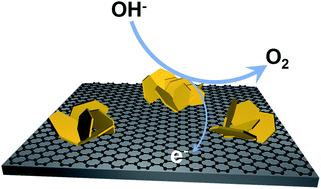Towards superior oxygen evolution through graphene barriers between metal substrates and hydroxide catalysts†
Abstract
The oxygen evolution reaction (OER) plays a key role in various sustainable energy systems, such as solar cells, fuel cells and metal–air batteries. The wise integration of transition metal compounds with macroscale current collectors is a promising strategy to achieve OER catalysts with high utilization efficiency. Herein, graphene with superior electron pathways, high surface area, excellent conductive and mechanical properties, and conjugate planes to anchor other phases with good dispersion was employed as the barrier between 3D Ni foam and NiFe-LDHs for 3D monolith electrodes. The as-obtained electrode exhibited a remarkably low onset overpotential of 240 mV, a small overpotential of 325 mV for 10 mA cm−2 and a substantially decreased Tafel slope of 44 mV dec−1 in 0.1 M KOH. The graphene barrier herein not only provides a novel hydrophobic substrate to modulate the growth of 3D NiFe-LDHs with good dispersion, but also delivers a strongly coupled interface between the active phase and current collectors. Consequently, the as-obtained graphene mediated 3D monolith electrode exhibited a very high electrochemically active surface area, an optimal interfacial junction, as well as superior OER performance. This work provides a novel catalyst for OER and more importantly, it reveals the role of graphene in modulating the interfacial features of various composites, which is general and can be employed in many material systems for satisfactory applications in heterogeneous catalysis, energy conversion and storage, sensors and so on.


 Please wait while we load your content...
Please wait while we load your content...